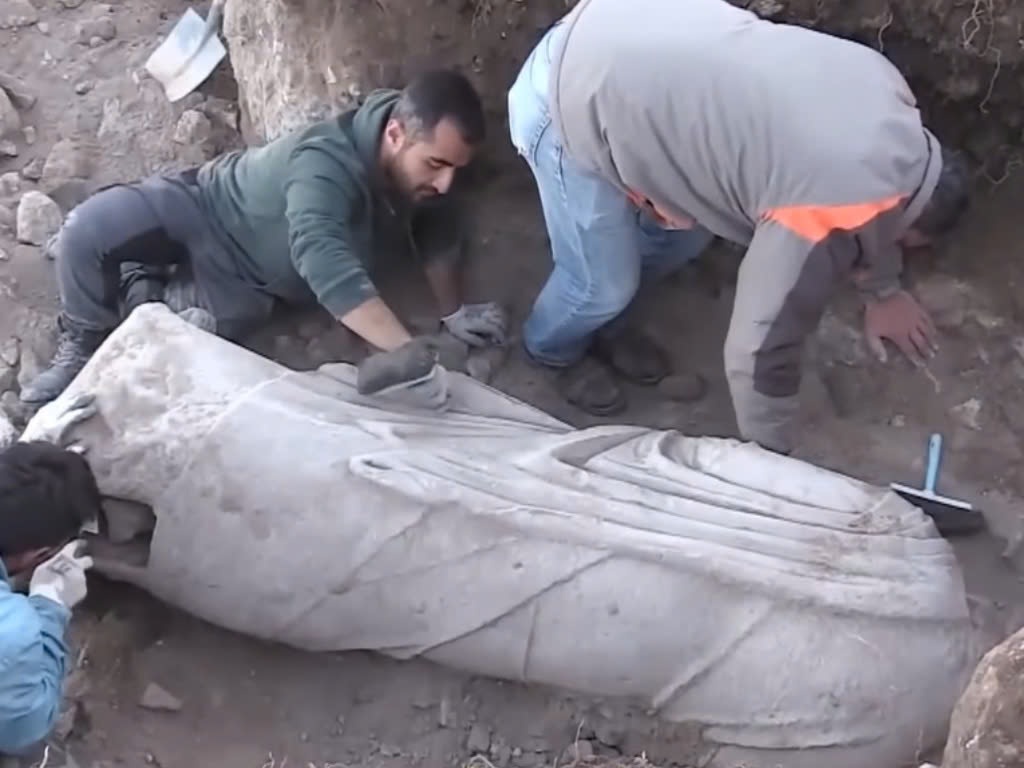In a groundbreaking archaeological find, two 2,000-year-old statues have been discovered in the ancient city of Blaundos, located in Turkey’s western Uşak province. These statues, believed to date back to the Roman period, were unearthed in the courtyard of the Temple of Demeter during an ongoing excavation. The discovery provides a fascinating glimpse into the artistic and cultural heritage of the region.
Blaundos: A Strategic Stronghold of Ancient Times
Blaundos, an ancient city steeped in history, is uniquely positioned atop a hill, surrounded by three streambeds. This natural geographic layout makes it resemble a peninsula, located approximately 40 kilometers from the city of Uşak. The city’s origins trace back to the Hellenistic period, founded by Macedonians in the wake of Alexander the Great’s military campaigns in Anatolia. Over time, Blaundos came under the control of the Kingdom of Pergamum before becoming a part of the Roman Empire. Its strategic significance endured through both Roman and Byzantine times, highlighting its enduring role in ancient geopolitics and trade.

Excavations in Blaundos: Unveiling Hidden Treasures
Since 2018, a joint team from the Uşak Museum and the Archaeology Department of Uşak University has been conducting systematic excavations in Blaundos. The ongoing efforts are focused on uncovering the secrets of this historic city, with particular attention given to the Temple of Demeter. Dedicated to the mythological Greek goddess of agriculture and fertility, the temple serves as a focal point for understanding Blaundos’ religious and cultural significance in antiquity.
The Discovery of Two Ancient Statues
The recent discovery of two statues in the courtyard of the Temple of Demeter has garnered significant attention. Dr. Birol Can, a faculty member of Uşak University’s Archaeology Department and the lead archaeologist for the excavation, shared the details of this remarkable find. The first statue, crafted from marble, measures approximately 185 centimeters (6 feet) in height and is missing its head. The second statue, also marble, is incomplete, with its head, right arm, and both legs missing. Despite these damages, the artistry and craftsmanship evident in both statues offer valuable insights into the artistic trends of their time.
Dr. Can remarked on the statues’ possible origins and purposes, stating, “We are still investigating whether these statues were integral to the temple itself or if they served as honorific monuments placed along the streets. They could represent deities, emperors, or prominent statesmen. Our research will continue to shed light on their identity and historical context.”
A Testament to Roman-Era Artistry
The statues are believed to be products of Roman-era craftsmanship, a time when the art of sculpture was reaching its zenith. Dr. Can noted that the artistic techniques employed in their creation could be traced back to the second half of the fourth century B.C., reflecting the enduring influence of classical Greek art on Roman sculpture. The intricate details and stylistic elements of the statues underline the sophistication of the artists and their ability to capture lifelike forms in marble.
After their discovery, the statues were carefully cleaned and subjected to thorough examinations to preserve their delicate features. They have since been transferred to the Uşak Archaeological Museum, where they will undergo further study and conservation. The museum plans to make these statues accessible to the public, ensuring that future generations can appreciate their historical and artistic value.
Blaundos: A Window into Ancient Life
The unearthing of these statues is more than just a remarkable find; it is a testament to the rich history and cultural significance of Blaundos. As an ancient city that thrived during the Hellenistic, Roman, and Byzantine periods, Blaundos offers archaeologists a wealth of opportunities to explore the interplay between art, religion, and daily life in antiquity. The discovery at the Temple of Demeter further solidifies Blaundos’ role as a center of artistic and religious activity.
Preserving the Legacy of Blaundos
The statues’ discovery has also sparked renewed interest in preserving the legacy of Blaundos. Ongoing excavations and research are not only unearthing physical artifacts but also piecing together the stories of the people who once inhabited this ancient city. By studying the statues, archaeologists hope to gain a deeper understanding of the cultural, social, and political dynamics of the region during the Roman era.
Moreover, the work being conducted in Blaundos highlights the importance of archaeological conservation and public education. By preserving these artifacts and making them accessible through museum displays, experts are ensuring that the legacy of Blaundos continues to inspire and educate.
A Broader Perspective on Roman Art and Culture
The discovery of these two statues contributes to the broader narrative of Roman art and culture in the region. Roman sculpture, heavily influenced by Greek artistic traditions, represents a blend of technical skill and cultural symbolism. The statues’ presence in the Temple of Demeter underscores the interconnectedness of religion, art, and politics in ancient societies.
The ongoing research in Blaundos is a reminder of how much remains to be discovered about the ancient world. Each artifact, no matter how fragmented, holds the potential to reveal new insights into the lives, beliefs, and aspirations of people who lived centuries ago.
A Discovery Worth Celebrating
The unearthing of the two statues in Blaundos is a milestone in archaeological research. It not only sheds light on the city’s historical significance but also enriches our understanding of ancient Roman art and culture. The collaboration between Uşak University and the Uşak Museum exemplifies the dedication and expertise required to bring these hidden treasures to light.
As the statues continue to be studied and preserved, they serve as a poignant reminder of the enduring legacy of ancient civilizations. Through these discoveries, the past comes alive, offering valuable lessons and inspiring awe for generations to come.





